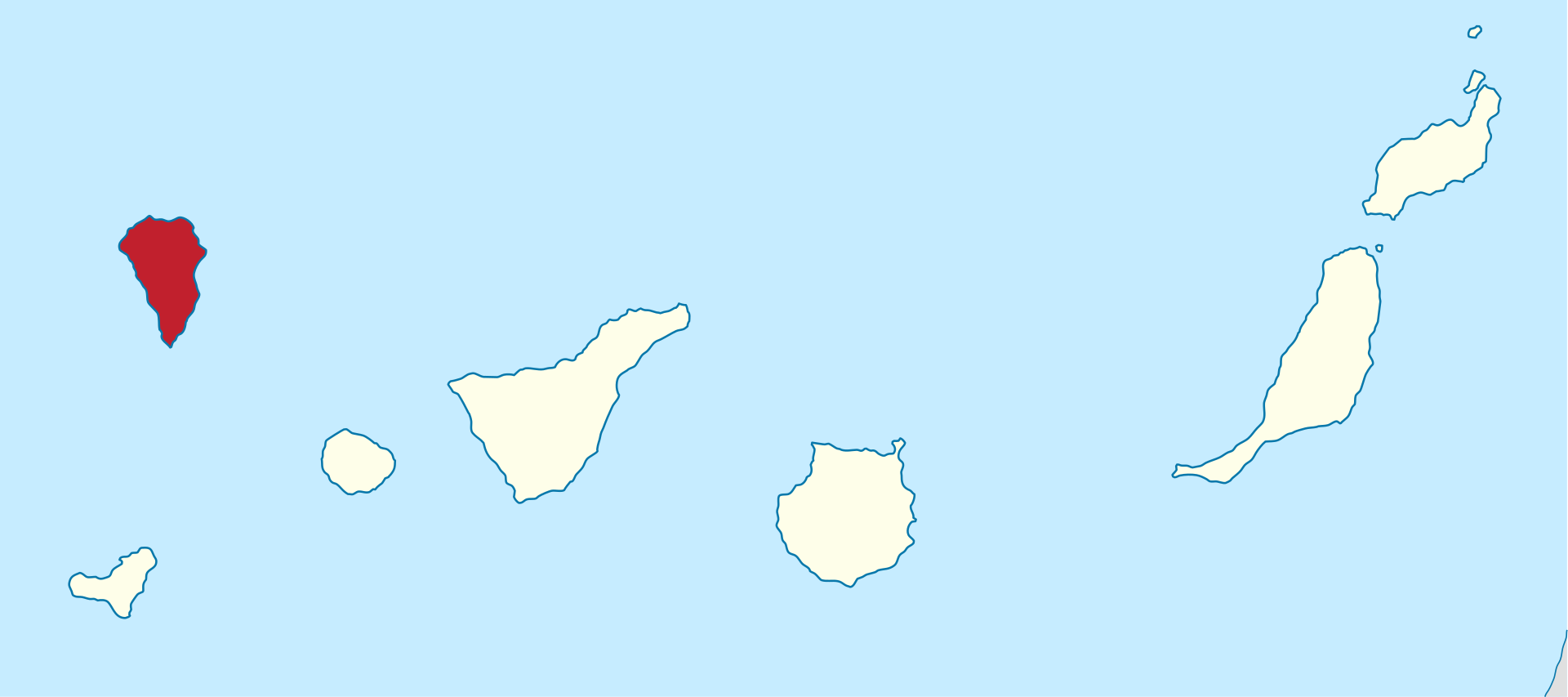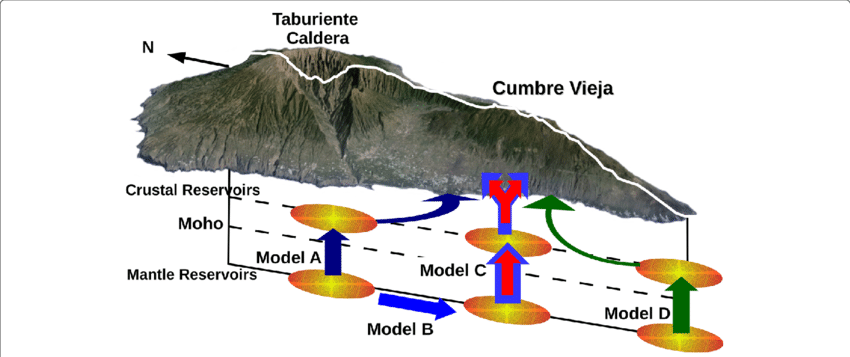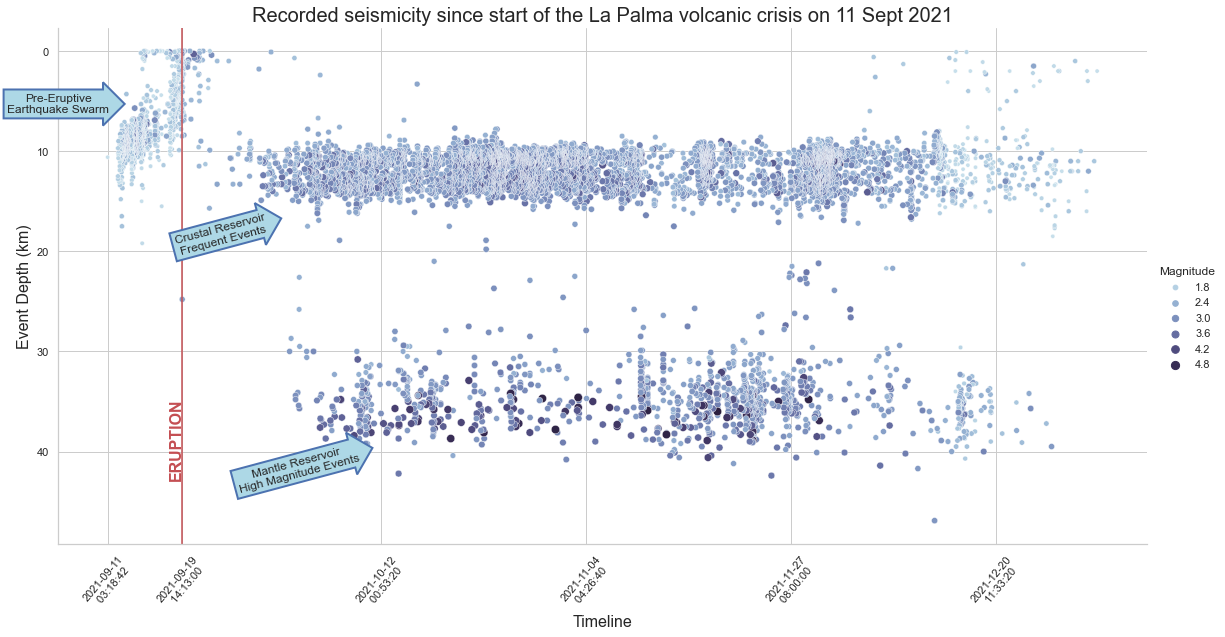La Palma Seismicity 2021
An analysis of earthquake swarms in relation to the 2021 eruption
Abstract¶
In September 2021, a significant jump in seismic activity on the island of La Palma (Canary Islands, Spain) signaled the start of a volcanic crisis that still continues at the time of writing. Earthquake data is continually collected and published by the Instituto Geográphico Nacional (IGN). We have created an accessible dataset from this and completed preliminary data analysis which shows seismicity originating at two distinct depths, consistent with the model of a two reservoir system feeding the currently very active volcano.
Introduction¶
La Palma is one of the west most islands in the Volcanic Archipelago of the Canary Islands, a Spanish territory situated is the Atlantic Ocean where at their closest point are 100km from the African coast Figure 1 The island is one of the youngest, remains active and is still in the island forming stage.

Figure 1:Map of La Palma in the Canary Islands. Image credit NordNordWest
La Palma has been constructed by various phases of volcanism, the most recent and currently active being the Cumbre Vieja volcano, a north-south volcanic ridge that constitutes the southern half of the island.
Eruption History¶
A number of eruptions were recorded since the colonization of the islands by Europeans in the late 1400s, these are summarised in Table 1.
Table 1:Recent historic eruptions on La Palma
Name | Year | dy |
|---|---|---|
Current | 2021 | 50 |
Teneguía | 1971 | 22 |
Nambroque | 1949 | 237 |
El Charco | 1712 | 35 |
Volcán San Antonio | 1677 | 31 |
Volcán San Martin | 1646 | 61 |
Tajuya near El Paso | 1585 | 94 |
Montaña Quemada | 1492 | - |
This equates to an eruption on average every 79 years up until the 1971 event. The probability of a future eruption can be modeled by a Poisson distribution (1).
Where λ is the number of eruptions per year, in this case. The probability of a future eruption in the next years can be calculated by:
So following the 1971 eruption the probability of an eruption in the following 50 years — the period ending this year — was 0.469. After the event, the number of eruptions per year moves to and the probability of a further eruption within the next 50 years (2022-2071) rises to 0.487 and in the next 100 years, this rises again to 0.736.
Magma Reservoirs¶
Studies of the magma systems feeding the volcano, such as Marrero et al., 2019 has proposed that there are two main magma reservoirs feeding the Cumbre Vieja volcano; one in the mantle (30-40km depth) which charges and in turn feeds a shallower crustal reservoir (10-20km depth).

Figure 2:Proposed model from Marrero et al
In this paper, we look at recent seismicity data to see if we can see evidence of such a system action, see Figure 2.
Dataset¶
The earthquake dataset used in our analysis was generated from the IGN web portal this is public data released under a permissive license. Data recorded using the network of Seismic Monitoring Stations on the island. A web scraping script was developed to pull data into a machine-readable form for analysis. That code tool is available on GitHub along with a copy of recently updated data.
Results¶
The dataset was loaded into a Jupyter notebook visualizaton and filtered down to La Palma events only. This results in 5465 data points which we then visualized to understand their distributions spatially, by depth, by magnitude and in time.

From our analysis in Figure %s, we can see 3 different systems in play.
Firstly, the shallow earthquake swarm leading up to the eruption on 19th September, related to significant surface deformation and shallow magma intrusion.
After the eruption, continuous shallow seismicity started at 10-15km corresponding to magma movement in the crustal reservoir.
Subsequently, high magnitude events begin occurring at 30-40km depths corresponding to changes in the mantle reservoir. These are also continuous but occur with a lower frequency than in the crustal reservoir.
Conclusions¶
From the analysis of the earthquake data collected and published by IGN for the period of 11 September through to 9 November 2021. Visualization of the earthquake events at different depths appears to confirm the presence of both mantle and crustal reservoirs as proposed by Marrero et al. (2019).
Appendix: Deeper Analysis of Previous Studies on Volcanic Eruptions in the Canary Islands¶
Review and Expansion of “Eruptive Patterns and Geological Impacts” (2022)¶
The Canary Islands have been a focal point of volcanological research due to their dynamic eruptive history and unique geological setting. This appendix section builds upon the findings presented in the influential 2022 study, “Eruptive Patterns and Geological Impacts,” which provided a comprehensive analysis of the patterns and consequences of volcanic eruptions across the archipelago over the past century.
Our deeper analysis extends the original work by incorporating recent data from the 2023 eruption on La Palma, which was not covered in the previous study. We applied advanced statistical models to the extended dataset, aiming to identify potential precursors to eruptive events that could enhance forecasting capabilities. Additionally, we re-examined the geological impacts described in the 2022 study, particularly focusing on the long-term changes in land use, vegetation recovery, and alterations in water resources following an eruption.
The results of our analysis confirm the increasing trend in eruptive activity mentioned in the 2022 study but also suggest a shift in the locations of the most active vents, potentially indicating a reconfiguration of the underlying magmatic systems. Furthermore, our examination of the post-eruption landscapes provides new insights into the resilience of the Canary Islands’ ecosystems and the effectiveness of current rehabilitation strategies.
In summary, by building upon the groundwork laid by “Eruptive Patterns and Geological Impacts,” this appendix aims to enrich the understanding of volcanic activity in the Canary Islands, offering a more nuanced view of its implications for both the natural environment and human societies residing in this geologically vibrant region.
Data Availability¶
A web scraping script was developed to pull data into a machine-readable form for analysis. That code tool is available on GitHub along with a copy of recently updated data.
- Marrero, J., García, A., Berrocoso, M., Llinares, Á., Rodríguez-Losada, A., & Ortiz, R. (2019). Strategies for the development of volcanic hazard maps in monogenetic volcanic fields: the example of La Palma (Canary Islands). Journal of Applied Volcanology, 8. 10.1186/s13617-019-0085-5